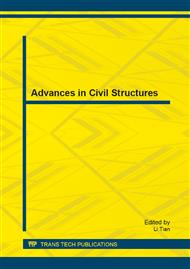[1]
Luo Xiongbiao, Chen Tie. Development trends of ultrasonic testing[J]. Nondestructive Testing, 2005, 27. In Chinese.
Google Scholar
[2]
Liang Hongbao, Zhu Anqing, ZHAO Ling. The newly research and application of ultrasonic testing technique [J]. Nondestructive Testing, 2008, 30(3): 174-177. In Chinese.
Google Scholar
[3]
Li Mingxuan. Controllability over the transient performances of piezoelectric transducers used in ultrasonic testing [J]. Applied Acoustics, 2008, 27(5): 338-344. In Chinese.
Google Scholar
[4]
ICHINOSE N, MIYAMOTO N, TAKAHASHI S. Ultrasonic transducers with functionally graded piezoelectric ceramics [J]. Journal of the European Ceramic Society, 2004, 24(6): 1681-1685.
DOI: 10.1016/s0955-2219(03)00599-5
Google Scholar
[5]
Huang Shifeng, Chang Jun, Cheng Xin. Preparation and polarization of 0-3 cement based piezoelectric composites [J]. Materials Research Bulletin, 2006, 41 (2): 291-297. In Chinese.
DOI: 10.1016/j.materresbull.2005.08.026
Google Scholar
[6]
Huang Shifeng, Ye Zhengmao, Cheng Xin, et al. Effect of forming pressures on electric properties of piezoelectric ceramic/sulphoaluminate cement composites [J]. Composites Science and Technology, 2007, 67 (1): 135-139. In Chinese.
DOI: 10.1016/j.compscitech.2006.03.035
Google Scholar
[7]
Wu Jinchuan, Cai Henghui. New technique for manufacturing high impedance backing composites [ J]. Technical Acoustics, 2008, 27(2): 214-216. In Chinese.
Google Scholar
[8]
Mihai State, Peter J. Brands, Frans N. van de Vosse. Improving the thermal dimensional stability of flexible polymer composite backing materials for ultrasound transducers [J]. Ultrasonics, 2010, 50(2010): 458-466.
DOI: 10.1016/j.ultras.2009.10.004
Google Scholar
[9]
Ki-Bok Kim, David K. Hsu, Bongyoung Ahn, Young-Gil Kim, Daniel J. Barnard. Fabrication and comparison of PMN-PT single crystal, PZT and PZT-based 1-3 composite ultrasonic transducers for NDE applications [J]. Ultrasonics, 2010, 50(2010): 790-797.
DOI: 10.1016/j.ultras.2010.04.001
Google Scholar
[10]
Dong Biqin, Li Zongjin. Cement-based piezoelectric ceramic smart composites [J]. Composites Science and Technology, 2005, 65 (9): 1363-137. In Chinese.
DOI: 10.1016/j.compscitech.2004.12.006
Google Scholar
[11]
Cheng Xin, Huang Shifeng, Hu Yali, et al. Effect of humidity on performance of 1-3 cement-based piezoelectric composites [J]. Journal of the Chinese Ceramic Society, 2006, 34(5): 626-629. In Chinese.
Google Scholar
[12]
G. Edward, H. L. W. Chan, A. Batten, K. H. Lam, H. S. Luo, D. A. Scott. PMN–PT single-crystal transducer for non-destructive evaluation [J]. Sensors and Actuators, 2006, 132 (2006): 434–440.
DOI: 10.1016/j.sna.2006.02.024
Google Scholar


